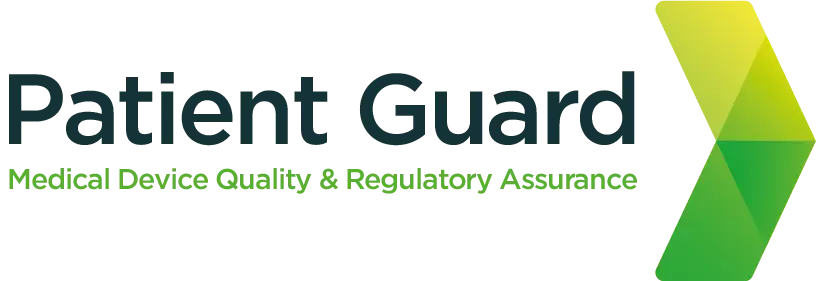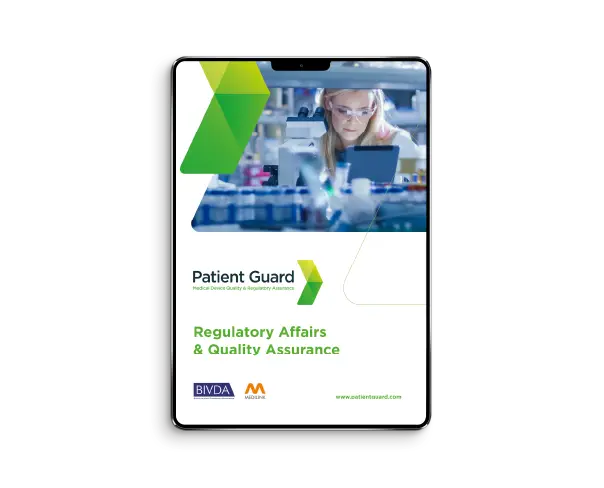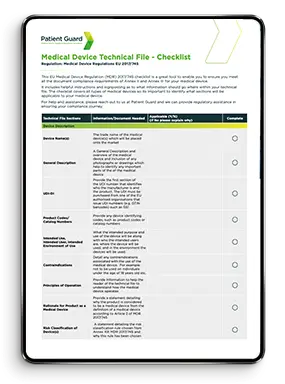Person Responsible for Regulatory Compliance (PRRC)
This blog will explain about the Person Responsible for Regulatory Compliance (PRRC) in relation to EU Medical Device CE marking under the MDR, and EU In Vitro Diagnostic CE marking under the IVDR. We will look at the necessary steps to ensure that your medical device or IVD is compliant with the medical device and IVDR EU market.

Background
Before the introduction of the Medical Device Regulations (MDR) and the In Vitro Diagnostic Regulations (IVDR) in Europe, there was no specific legal requirement for medical device or IVD manufacturers to check their documentation or ensure that their devices were compliant. It was implied within other parts of the previous regulations such as drawing up technical documentation and declaration of conformities etc., but it was never legally stated that this was required to be completed by or verified by a qualified person.
This made it much easier for poor quality or counterfeit medical devices to enter the marketplace and for post-market surveillance of those devices to be inadequate. This in turn leads to missed opportunities for Notified Bodies and Competent Authorities in stopping potential adverse incidents from occurring.
Consequences
Most notably, this is exampled in the case of the PIP breast implant scandal that came to light in 2010, when it was identified that instead of medical-grade silicone being used, the Chinese supplier changed the silicone in the manufacturing process to an unauthorised grade, leading to the implants to rupture, the effects of which are still being felt by over 40,000 women who were implanted with them to this day.
Another issue also raised in 2010 was the DePuy Orthopaedics Inc metal on the metal hip implant recall. The recall came after data from a study indicated that the five-year failure rate of this product is approximately 13% or 1 in 8 patients. Even if the defective device is replaced, it can leave behind dangerous, possibly deadly fragments that may not be discovered for years.
DePuy identified reasons for the failure of the hip replacement system as component loosening, component malalignment, infection, fracture of the bone, dislocation, metal sensitivity and pain. Additional complications from the hip replacement system may include increased metal ion levels in the blood, bone staining, necrosis, swelling, nerve damage, tissue damage and/or muscle damage.
A need for change
The investigations into these scandals identified several significant failures, with blame being apportioned to the suppliers, manufacturers, Notified Bodies and Competent Authorities. To the suppliers for lack or poor Quality Control (QC) measures and procedures, the manufacturers for poor verification and validation procedures, as well as poor control over their suppliers. The Notified Bodies for not identifying issues during surveillance audits and the competent authorities for lack of scrutiny in the proof that these devices were effectively safe.
This led to more robust legislation being drafted to ensure that these issues were addressed as well as making the new legislation reflect the significant technological advancements within the industry since the initial regulations were implemented back in 1993.
New Regulations
The European Medical Device Regulation (MDR) EU 2017/745 and In Vitro Diagnostic Device Regulations (IVDR) EU 2017/746 which were introduced in 2017 and came into force on May 21st, 2021 (a year delay due to covid, originally were due to come into force in May 21st, 2020) and May 21st, 2022, respectively.
Since then there has been an extension, to Article 120 of the regulations. This is in relation to legacy devices that need to have notified body approval. The extension has been implemented to allow notified bodies longer to get through the back log of legacy devices that are still not MDR compliant. Further information on this can be found in our blog; “MDR & IVDR Article 120 – Why has the EU moved back the timeframes?“.
The regulations introduce a raft of new measures and requirements on Medical Device Manufacturers, Distributors, Importers, Authorised Representatives, Notified Bodies and Competent Authorities.
PRRC - Article 15 - MDR & IVDR
Part of these new measures is the introduction of a Person Responsible for Regulatory Compliance (PRRC). Article 15 of regulations EU 2017/745 (MDR) and EU 2017/746 (IVDR), the legal requirements for the PRRC are presented.
They state that each manufacturer and authorised representative (if applicable) must have at their disposal a PRRC, who has the necessary requisite qualifications and experience for regulatory compliance.
What does a Person Responsible for Regulatory Compliance do?
The PRRC is responsible for the following:
- The conformity of the devices is appropriately checked, by the quality management system under which the devices are manufactured, before a device is released
- The technical documentation and the EU declaration of conformity are drawn up and kept up to date
- The post-market surveillance obligations are complied with by the regulation
- The reporting obligations to Notified Bodies (if applicable) and Competent Authorities are fulfilled
What are the qualifications needed?
The qualifications required to be a PRRC are as follows either:
- A diploma, certificate, or other evidence of formal qualification, awarded on completion of a university degree or of a course of study recognised as equivalent by the Member State concerned, in law, medicine, pharmacy, engineering or another relevant scientific discipline, and at least one year of professional experience in regulatory affairs or in quality management systems relating to medical devices.
- Or four years of professional experience in regulatory affairs or in quality management systems relating to medical devices.

Who needs to have a PRRC?
Medical Device Manufacturers, Importers, Authorised Representatives are all required to have their own PRRC. Guidance on PRRC requirements are given in EU guidance document: MDCG 2019-7 Rev.1.
Micro and small enterprises (companies that turnover of fewer than 10 million Euros per year and have less than 50 employees) shall not be required to have the person responsible for regulatory compliance within their organisation but shall have such person permanently and continuously at their disposal.
This means the PRRC may be subcontracted to a professional as for small companies this may not constitute a full-time role and the recruitment costs could be inhibitive.
Does it affect me?
If you are the legal manufacturer and CE mark holder of a medical device (as well as own-brand labelled devices) and sell them into the European Union (EU) including Northern Ireland, then you are legally required to have a PRRC permanently at your disposal regardless of the classification of devices you sell.
What is the cost of employing a Person Responsible for Regulatory Compliance?
Typically, if you employ someone with the necessary qualifications and experience you would be looking at the following average costs in the UK.
- Quality Assurance: £22,000-£36,000 Average base pay (Glassdoor.co.uk, UK. March 2024)
- Regulatory Affairs: £31,000 – £61,000 Average base pay (Glassdoor.co.uk, UK. March 2024)
The cost of hiring a manager in each of these areas would be significantly more.
- Quality Assurance Manager: £35,000 – £54,000 Average base pay (Glassdoor.co.uk, UK. March 2024)
- Regulatory Affairs Manager: £38,000 – £60,000 Average base pay (Glassdoor.co.uk, UK. April 2022)
These are based on roles for all industries in England, so it’s likely that medical device-specific roles would cost more than these figures.
How much time is involved in the Person Responsible for Regulatory Compliance (PRRC) service?
Depending on how many medical device products the company has in their portfolio and the number of devices placed on the marketplace, as well as the complexity of those devices in terms of classification (I, Is, Im, IIa, IIb, III) will dictate how much time and effort would need to be placed in ensuring ongoing compliance with the medical device regulations.
For the average Micro and small enterprises (companies with a turnover of fewer than 10 million Euros per year and have less than 50 employees), this is unlikely to be a full-time role (37.5 hours per week) in terms of time and effort required to maintain the ongoing regulatory requirements once the device is placed onto the market.
Therefore, it makes much more sense from a cost perspective to outsource this to a professional service provider. For example, Patient Guard is a company that specialises in this area and typically will cover this for clients with 8 hours of work (2 hours per week) in the month.
What will happen if I don’t have a PRRC?
Due to this being a legal requirement, there are significant penalties for companies that do not have a PRRC in place. This could be punishable by a large fine or even a prison sentence.
When do I need to be compliant by?
As soon as you place product on the EU market under the MDR or IVDR, you must have a PRRC in place.

How Can Patient Guard Help?
Patient Guard is a Medical Device Consultancy established in 2017, our experts are all qualified and experienced for the requirements of being a Person Responsible for Regulatory Compliance (PRRC) for both the EU MDR and the EU IVDR. Contact us to see how we can support you with your PRRC legal obligations:
FAQs
A Person Responsible for Regulatory Compliance (PRRC) is a regulatory role mandated under the EU Medical Device Regulation (MDR 2017/745) and In Vitro Diagnostic Regulation (IVDR 2017/746). The PRRC ensures that a manufacturer complies with regulatory requirements throughout the device lifecycle.
Why it matters: Appointing a PRRC is mandatory for EU medical device and IVD manufacturers and essential for ensuring compliance with MDR and IVDR regulations.
A PRRC must have:
- Qualifications: A university degree in law, medicine, pharmacy, engineering, or a related field.
- Experience: At least one year of professional experience in regulatory affairs or quality management systems for medical devices.
For smaller manufacturers without in-house expertise, the PRRC role can be outsourced to a qualified consultant.
Pro tip: Ensure the PRRC has adequate expertise in the regulatory frameworks applicable to your device class and market.
The PRRC is responsible for:
- Product Conformity: Ensuring that devices conform to MDR/IVDR requirements.
- Technical Documentation: Overseeing the preparation and maintenance of documentation.
- Post-Market Surveillance (PMS): Ensuring PMS activities are conducted and reports are generated.
- Vigilance Reporting: Reviewing and reporting adverse events to the relevant authorities.
- Regulatory Compliance: Ensuring Declaration of Conformity and CE marking requirements are met.
Key insight: The PRRC acts as the compliance backbone for manufacturers operating in the EU market.
Yes, all manufacturers of medical devices and IVDs intending to market products in the EU must appoint a PRRC. This includes:
- EU-based manufacturers.
- Non-EU manufacturers, who must appoint a PRRC via their EU Authorized Representative (EU AR).
Key takeaway: Non-compliance with the PRRC requirement can result in regulatory penalties or denial of market access.
- PRRC: Ensures compliance with MDR/IVDR and oversees regulatory and quality activities.
- EU Authorized Representative (EU AR): Represents non-EU manufacturers in regulatory matters and acts as the point of contact with EU authorities.
Key insight: While the EU AR can appoint a PRRC on behalf of a non-EU manufacturer, the two roles have distinct responsibilities.
Yes! Patient Guard offers professional PRRC services, including:
- Acting as the PRRC for EU-based or non-EU manufacturers.
- Overseeing technical documentation, PMS, and vigilance activities.
- Ensuring compliance with MDR/IVDR requirements.
- Supporting regulatory audits and inspections.
Why choose Patient Guard: With extensive experience in regulatory compliance and MDR/IVDR expertise, we provide tailored PRRC solutions to meet your business needs efficiently.



